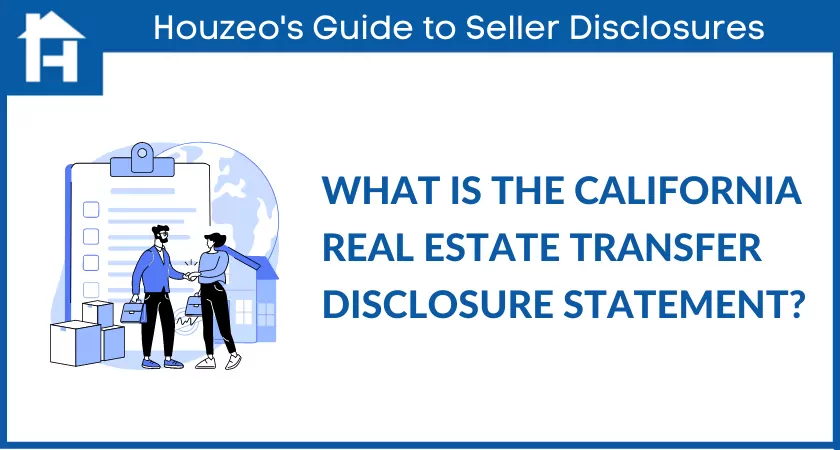
What is the California Real Estate Transfer Disclosure Statement?
The Transfer Disclosure Statement, also known as CA RETDS or just TDS, is legally required. The California Civil Code under Section 1102 (CAL. CIV. §1102.3) requires that every residential seller complete a TDS for the buyer. This document is one of the seller disclosures buyers receive during their contract contingency period.
TDS is one of the most complex disclosures in California. This form is similar to most seller disclosures. Further, a disclosure statement is used as evidence in lawsuits. And given how comprehensive the document is, it should be carefully handled.
Different sections in the California Real Estate Transfer Disclosure Statement
The TDS has 5 sections:
- Coordination with Other Disclosure Forms
- Seller’s Information
- Agent’s Inspection Disclosure – For Seller
- Agent’s Inspection Disclosure – For Agent
- Additional Professional Advice and/or Inspections
Coordination with Other Disclosure Forms
The RETDS must be disclosed with the other disclosures required by the state of California. The seller fills in section 2 of the Real Estate Transfer Disclosure. The seller must provide any inspection reports with pertinent information.
Seller’s Information
The seller has to cover items on the subject property that the seller is aware of. Therefore having actual knowledge of available appliances, leaky roof to whether any deaths occurred on the property in the last three years.
This form is not a warranty, but it is a reliable source of information for the buyer. Hence this shows the seller has disclosed all items not in operating condition. Further, it is classified into sub-sections:
A) Occupancy:
Sellers should indicate whether they are presently living in the property.
B) Section A:
Appliances Systems and Other Items: Here the sellers disclose:
- All the appliances like kitchen range, dishwasher, central heating/air conditioning, sprinklers, and hot tub.
- All electricity, gas, and water supply details.
- Any chemicals on the property — for example, if marijuana or methamphetamine was grown there.
- Major neighborhood disturbances such as rush-hour traffic or adjacency to an airport.
- Any encroachments, easements, or other issues affecting a seller’s interest in the property.
- Any common area—such as a pool or walkway—co-owned in undivided interest with others.
C) Section B:
Defects/Malfunctions
- Although this cuts down on a seller attempting to cover up the home’s defects. Such as walls/fences, electrical systems, insulation, flooding, drainage, grading, plumbing, sewers or septic problems.
- If you are aware of any significant defects or malfunctions in any of the following items in Section B, you will need to describe them.
D) Special Questions:
A lengthy list of 16 yes-or-no questions is designed to cover what is unaddressed in Sections A and B. You should read each question carefully and think before answering. This includes:
- Room additions or modifications to the property.
- Major damage to the property from fire, earthquakes, floods, or landslides.
- A homeowner’s association has no authority over the property.
- Any notices of abatement or citations against the property.
- Fill, compacted or otherwise, on the property or any portion thereof.
Agent’s Inspection Disclosure – For Sellers and Agent
Visual inspection of the accessible areas of the property. However, your listing agent should complete the agent’s inspection disclosure. Hence, a buyer’s agent will complete a separate section.
Under no circumstance should an agent ever check the box that says there are no items for disclosure. Further, there are always items to disclose.
Additional Professional Advice and/or Inspections
Seller signs off and allowing the buyer to do any additional home inspections on the property before buying the house in California.
Hence if a buyer decides to sue a seller for non-disclosure this three-page document can be used as supporting evidence in court. That’s why it’s very important that sellers fill it out correctly and disclose pertinent information, which may affect the buyer’s decision to move forward with the purchase.
If you need help preparing a transfer disclosure statement or have further questions, please consult a real estate lawyer.
» How to Sell My House Fast in California: Know How to Sell Your House Fast in California and for the Most Cash!
Related Keywords: transfer disclosure statement, transfer disclosure statement california, what is a disclosure statement, real estate transfer disclosure statement, california real estate disclosure forms, real estate disclosures california, california real estate disclosure checklist, transfer disclosure statement california form, real property transfer disclosure statement, transfer disclosure, transfer disclosure statement definition
















